There has been much discussion of the Vital Wave Consulting total cost of ownership model showing a $2,700 5 Year TCO
This report models the cost for a secondary school to install a computer laboratory to support a course in computer literacy (often called ICT). This course consists of classroom lectures based on textbooks with hands-on computer access during scheduled laboratory periods ('students are not permitted in the computer lab without a teacher present').
The model seems to be based on the educational ideas of the eighties of last century. Those were the times when children were expected to encounter computers only in University or at work. It is obvious that children in India, and the developing world in general, need to prepare for a future which places larger demands on their education and where they are expected to spend a lot of time on-line.
Not only higher education, but also information gathering, communication, work, and good citizenship in general are expected to involve the internet and (mobile) computers in a developed economy. Therefore, the use case selected by Microsoft is really decades behind the times.
Instead of letting the teaching of "Computer Literacy" compete with other subjects in the curriculum, computers should be used to improve and enhance the existing curriculum.
VWC's report does not mention OLPC or it's fundamental premise: that every child should have a laptop to use in and out of class. In the following, we first try to contrast the TCO model appropriate for the OLPC with the model in the Vital Wave report. Where possible we have tried to use the assumptions and cost estimates in the report. Then we will contrast this small scale deployment model with a TCO model of a very large deployment of 1:1 XO computers, thousands of schools in a large area.
TCO of a Small Deployment of 1:1 computers in school
The TCO Model in the Report is based on two costs: (1) the direct cost of computer acquisition (initial and ongoing), and (2) the indirect costs to set up and sustain the computer laboratory.
The Report assumes the computer lab consists of 16 computers ('seats') where one is also a server. The study assumes a school year of 39 weeks, 5 days per week, and 3.5 hours lab time per day (682.5 hours). Assume the school enrollment is 160 (not mentioned in the Report), so that an average student gets 68.25 lab hours per year or 1.75 hours per week.
The OLPC model, by contrast, is based on each child in a primary school having an XO throughout the class day and at home on evenings, weekends and holidays. Each child receives a laptop when he/she enters the second grade and keeps it when he/she leaves the fifth grade (this keeps both schools at four years). The laptops are supported by a school server which provides access to additional content and the internet. The costs of hardware maintenance is covered by purchasing extra laptops.
Assuming a school of 160 students, at least 160 XOs will be needed. Assume a steady-state situation in which each child entering the school in the second grade gets an XO. Each child keeps his XO throughout the primary years (grades 2 thru 5 as assumed in the study). The school purchases an additional 5 XOs per class to provide for loss, damage, repair, incoming transfers, and the teacher.
In addition the OLPC model assumes a dedicated computer (XS) per school which provides internet access, provides backup for the XOs, caches instructional materials, and supports a CMS (Moodle). Each child has a computer which could be used each day for six hours in class and two hours at home (plus ten hours on weekends). This is approximately 1800 hours per year - let's assume 1000 hours, ie, around 20 hours a week.
Direct Computer Costs
First, look at the direct computer cost, excluding initial setup, training, connectivity to the internet, electricity, and Tier 1 (software) support.
Case 1: Public Secondary School (grades 9-12) sets up a computer lab with 16 desktops (one is also used as a server) to teach ICT. The total cost is $8000 (16 computers @ $500) with a per seat cost of $125. This is a approximately $0.18 per hour for computer access ($125/682.5).
Case 2: Public Primary School (2-5) provides each child and four teachers with an XO. The initial purchase for this school is 160 + 4 (teachers) + 4 (reserve) for a rounded-up total of 170 at $200 each ($34000). The annual buy is 45 laptops at $200 per student ($9000). A dedicated server per school costs $500 (headless mainstream desktop). This is a total cost of $34500 ($216 per student).
If we assume utilization of 1000 hours per year, the cost is($216/4000) or 5 cents per hour. Note: if fifth year students keep their laptop, the school must begin buying 45 more laptops in the second year. Since we are focused on student usage, these new laptops service additional students. This factor is omitted to keep the model simple (the new laptops serve new students, ...)
Next, the indirect costs:
Case 1: the computer lab pays $33886 total for initial setup ($5351), training ($10620), software support ($10920), hardware support ($2432), electricity and internet connectivity ($5351), and damage and theft ($2640). This increases the computer lab cost to $2500 (41886/16) per seat and approximately $2 per computer access hour ($41886/16/4/312).
In case 2, the costs of Tier 2 and 3 (hardware maintenance) and the costs of damage and repair are handled by purchasing extra XOs. In the OLPC case the extra cost is $28314 (excluding $5072). The OLPC total cost is $70000 ($41500 + $28316). This is $437.50 per student or $109.38 per year and 10.9 cents per hour.
The explanation for much of the difference between the Report's TCO model and the OLPC model is that the so-called hidden costs are 'per school' and not 'per computer'. However, the fundamental difference is that OLPC means that students are not learning to use a computer, they are using a computer to learn.
This simple comparison shows that a single school deployment of 1:1 XOs could get year round computer access for all children. Which, obviously, has a profound influence on homework assignments and teacher-student/student-student communication. 1:1 deployment also allows to start using electronic books instead of paper ones. All of these benefits are not part of a school lab. However, a much larger difference between the deployments is that the computer lab is only useful for high school children. 1:1 laptop deployment can be used for all school children.
A Large Deployment of 1:1 computers in school
Much is generally made from the cost of training and support of large scale 1:1 deployments. However, this can easily be incorporated into the models. The basis of the following TCO model is a large-scale deployment in Indonesia as discussed in One Indonesian Laptop Payment Plan Per Family. The model is contrasted with the Vital Wave model and the model discussed in What is the Real Cost of the OLPC?.
The TCO model given below is a "plausible" model based on pure guesswork. To understand why these TCOs are so way off from other "commissioned" TCO studies (like What is the Real Cost of the OLPC? and Vital Wave Consulting: A Total Cost of Ownership (TCO) Model for Education Officials), the cost difference between wiring up a single school and training a dozen teachers by US personnel, and wiring up 10,000 schools and training tens of thousands of teachers by local people must be factored in. This is illustrated by using the Indonesian example.
An Indonesian teacher earns up to $1000 a month. A local trainer will be rich if she earns $2000 a month. Applying a US ex-pat might cost $10,000/month and more. Setting up 60 computers for the first time is hard work, setting up a hundred thousand imaged XOs is a routine chore. For 10,000 schools you definitely can get a good deal on internet access, say, by a special deal with a mobile phone provider. But as it is not known how such deals would work out, this will not be discussed.
The TCO guesstimates are "inspired" by the numbers given in What is the Real Cost of the OLPC?:
Over 10,000 schools using XOs, so fixed costs can be ignored. Only variable costs will add up. This means, the cost of the training curriculum and materials, as well as the cost of the XO image and software updates become vanishingly small on a per laptop basis.
Assumptions
6 year deployment of XOs (grade 1-6)
4 year average lifetime of XO (breakage and loss)
1 week training per teacher per year
30 pupils per teacher
1 server per 60 pupils, expected lifetime 3 years, so 2 servers will be needed
1 School server costs $500 + $300 for shipping + set up
1 gang charger per 30 pupils $250
Batteries cost $10 and should run for 2000 charging cycles, which comes down to 6 charges a week over a period of 6 years. The batteries should last for 6 years so replacements will be ignored here.
Training Costs
1 Trainer earns $500/week, trains 25 teachers "locally"
1 Teacher earns $250/week
150% overhead for additional costs and on-line follow up
Training ($500/25 * 2.5) = $50
Teacher's salary = $250
----------------------------
Summed: $300 * 6 years = $1800
Per pupil: $1800/30 = $60 TCO training
Per Student Computer Costs
Setup per XO: $5
2 school servers: $1600 /60 pupils = $27
1 gang charger $250/30 ~ $9
Together:
$200 1 XO
$100 0.5 XO replacement
$5 XO setup
$60 1 week teacher training / year for 6 years
$27 School server
$9 Gang charger
------------
$401 Computer infrastructure
Electricity Costs:
We take a worst case scenario, with the XOs being on most of the time for a total power consumption triple that of the actual use
3 * 10Watt * 1000 hours/year
(note that the charging power is higher than the consumption power, I guess in the order of 10W charging for average use)
30kWh/year per XO = 180kWh total
The current production price of electricity on Java is around 200 Rp/kWh ~ $0.022/kWh (2006/2007) Thus, 180kWh/year * $0.022/kWh ~ $0.4/year production cost. But let us take the cost at $10 a year on delivery (5.5 cents / kWh) for a total of:
$60 Electricity
Networking Costs:
$10 per laptop for 6 mesh repeaters per 60 pupils of $100 each, in total $600/60
$X Internet connectivity, one connection per 60 pupils
Together: $471 + $X TCO
Add to this the cost of an XO for each teacher at $471/30=$15.70 per pupil extra for a total of ~$490 per student XO. At $490 per pupil for six years, the costs would come to $490/6 = $81.67/student-year or $490/6000 = 8.17 cents per hour (this includes both the direct and indirect costs). So the TCO per student under this model for 6 years is $490 or $81.67 per year and $0.0817 per hour.
Conclusions
The differences between the XO TCO models are the time window (6 years instead of 4 years) and the training, which is based on one week per year per teacher. This is a much better estimate for teacher training in a country like Indonesia or India than a one time training session at the start of the project.
Notice that maintenance and software support are centralized in the mass deployment of the XO. There is only a one time set-up cost of $5 when the XO is personalized. The XO uses "viral" secure updates in the field. Furthermore, messed up laptops can be reset to a pristine state by a simple "button push". Likewise setups will be used for the servers.
Therefore, any talk of "expensive Linux personnel" is irrelevant as there is no field maintenance for the software. From the viewpoint of the students and teachers, an XO is much more an appliance like a microwave oven than a fully configurable computer. There might be field work for maintaining the hardware, but here broken laptops are simply replaced.
The most important "lesson" to draw from this exercise is how "malleable" TCO is. For instance, a simple change in the time window, 6 versus 4 years can increase TCO from ~$80 per year to ~$110 per year per student for a minimal difference in total cost $490 versus $437.50. That is, the total costs are amortized over more time reducing TCO per year by 27%. And if the use is cranked up from 1000 to 1500 hours a year, the hourly costs reduce to only 5.5 cents.
Another lesson to learn is how little the total costs for XO deployment differ: 11% for two completely different deployment models. This is not only the result of coincidences, but also of the design of the XO, which shunned all field maintenance and actually has almost zero maintenance requirements:
- Cheap, replace instead of repair
- Reset button
- Automatic back-up and versioning
- Viral software updates
- Security
- 21st century educational model (eg, mesh)
Reports that the OLPC will deliver a $300 total maintenance plan for deployment look rather plausible given these calculations.
Authors of this XO TCO Study
Winter and Tony Anderson wrote this post collaboratively, based on their previous OLPC News comments and the earlier posts by Jon Camfield.
Links & References
- Vital Wave Consulting:A Total Cost of Ownership (TCO) Model for Education Officials
- Surprise! 5 Year TCO for Computers in Schools: $2,700
- What is the Real Cost of the OLPC?
- One Indonesian Laptop Payment Plan Per Family
- XO Laptop as Library of Alexandria
- Quick guide: Monitoring and evaluation of ICT in education initiatives
- CERI-KERIS International Expert Meeting on ICT and Educational Performance
- A Review of the Literature on Computer-Assisted Learning
- Education is a Basic Need in the Developing World
- OLPC XO: A Cost Effective Violin
- OLPC XO Will Improve Teacher Productivity
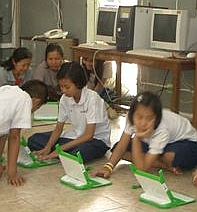
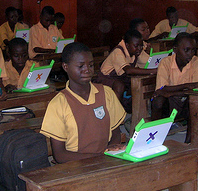
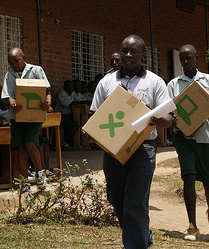
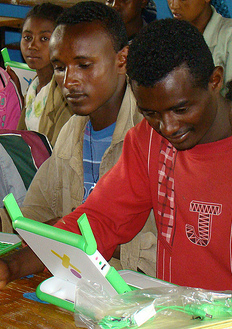
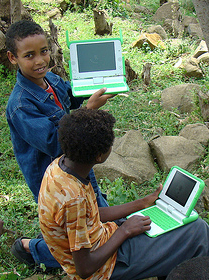


"Happy Ghanaian XO's"
In that photo, those are kids and laptops in Rwanda, not Ghana.
A small correction:
The electricity prices in Indonesia are higher than the 5.5 cents on which our $10/year for 180 kWh/year was based:
http://www.atimes.com/atimes/Southeast_Asia/JF10Ae01.html
"[Philippines' 17.5 cents per kWh] is more than three times the 5.38 per kWh cost in Vietnam, and is markedly higher then the 6.77 per kWh cost in Indonesia, 7.67 per kWh in Malaysia and 8.50 per kWh in Thailand. Even high-cost Singapore recorded cheaper power rates at 13.07 per kWh."
If we use 7.5 cents per kWh (higher oil prices), the total price would be $13.50, ie, $3.50 extra over 6 years. This adds 58 cents per year or 0.058 cents per hour for a total of 8.23 cents per hour.
In other words, at the prices charged in South-East Asia, electricity won't be the bottleneck.
Winter
The second sentence in the correction above should read:
"The electricity prices in Indonesia are higher than the 5.5 cents on which our $10 for 180 kWh was based"
Thank you for the very interesting and thorough post! I think it is really timely in light of the recent news about a deal NComputing has signed with the Indian government. Would be possible to have a similar comparison between XO and the NComputing solution? I can clearly see conceptual/philosophical differences between the 1:1 laptop approach and the lab approach, but i wonder what happens when we compare the costs. Thanks!
@Dima:
"Would be possible to have a similar comparison between XO and the NComputing solution?"
I am not sure we could actually get hold of the real costs used in NComputing deployments.
I also read a comment somewhere that NComputing and MS disagree about the CALs (Client Access Licenses) needed to run the thin clients. If they go for the full cost, the deployment becomes more expensive. These server license+CAL costs are kept secret by MS for obvious reasons.
However, I see the Vital Wave report as ammunition behind NComputing tenders. But if we replace NComputing computers by XO laptops in school ICT labs, we have won little. It is the school lab computer literacy programs that are the root of the difference (and problem).
The basic problem with computer lab deployments is that their ICT (Computer Literacy) program competes with the other subjects in the curriculum. In addition to that, these school lab programs are based on computer use practices of the 1980s.
I do not think India would want to invest these large sums of money to bring their schools to the 1988 level if they can go for the 21st century.
Winter
Cross post from
http://www.olpcnews.com/countries/nepal/olpc_nepal_now_1.html
A high end estimate for internet access based on Vital Wave's study.
Ties,
I obviously should have used Vital Wave's estimates for the high end prices:
http://download.microsoft.com/download/2/0/a/20ac945c-34d0-4a60-8245-f80e80fe954f/Vital_Wave_Consulting_Affordable_Computing_TCO11June08.pdf
Page 12
Rural: $3600 Urban: $2100 (5 year)
Where the rural case is for dial-up and the urban one for broadband DSI.
This would come down to $720 - $420 a year.
This is for the 16 computers in a computer lab. If we throttle down the bandwidth per student to get the same bandwidth for 60 pupils, we end up with $12 - $7 a year per student, or 1.2-0.7 cents per hour. A significant portion of the total costs.
So this means the rural access point servers must cache most of the pages and might have to work with an urban proxy that uses heavy compression for communication. I think schools will have to stimulate students to work with pictures blocked (which would also help with some "filtering" problems).
So this is an estimate of high-end low-bandwidth (worst case) prices: 1.2 cents per hour internet costs.
Winter